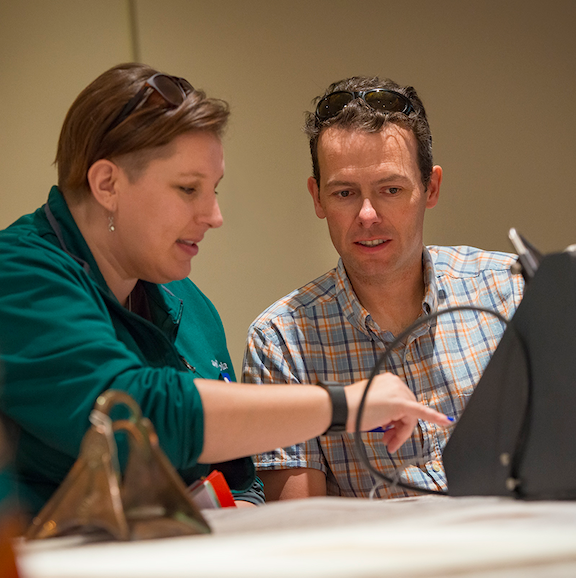In this type of learning, objects (specimens, museum artifacts, 2-D and 3-D art, books, lab equipment, medical devices etc…) are used as the basis of learning (Chatterjee and Hannan, 2015). Object-based learning is multimodal. Multiple senses are engaged. Objects can inspire curiosity and hypothesis making, particularly when the purpose or intent of the object is difficult to discern. Objects can precipitate discussion and teamwork (Chatterjee and Duhs, n.d.).
In the picture to the right, a LAMP fellow and mentor engage in object-based learning at the University of Wyoming Art Museum. During our object-based learning sessions, we begin with the practice of deep looking. We then allow learners to experience some immersion in the drawing techniques of blind contour sketching and mark making. Below are some prompts that can guide deep looking and blind contour sketching:
-
Look at your chosen piece for a full 5 minutes. Follow your thoughts, emotions and overall response to the object.
-
Set your watch for another 5 minutes. During this 5 minutes, write observations in your field notebook about the work. Notice whether you tend to want to write interpretations rather than observations. This is okay but try to bring yourself back to writing observations. That is, what do you see?
-
Now, select just one small part of your chosen piece. Keep your eyes on this part while you sketch it in your field notebook. Keep your pencil touching the paper but keep your eyes only on your chosen part of the art work. Do not lift your pencil for ~5 seconds. After five seconds, lift your pencil and move to another part of the paper. Begin sketching again. Repeat this six times.
-
In this process, what did you notice? What did you wonder? Of what did this remind you?
For many scientists this is a learning space that is unfamiliar and this allows them to reflect on student’s experience of learning something new. Additionally, we ask our LAMP fellows to connect their science to the art. We remind them of the practice of detailed drawing that is needed for lab notebooking. We push them to think about the similarities between public scrutiny of art and science.

References and Resources
Chatterjee, H.J. & Hannan, L. (2015) Engaging the Senses: Object-Based Learning in Higher Education. New York, NY: Routledge.
Chatterjee, H.J. & Duhs, R. (n.d.) Object Based Learning in Higher Education: Pedagogical perspectives on enhancing student learning through collections. Available: http://arts.brighton.ac.uk/__data/assets/pdf_file/0010/18649/01-Object-based-learning-in-higher-education.pdf

